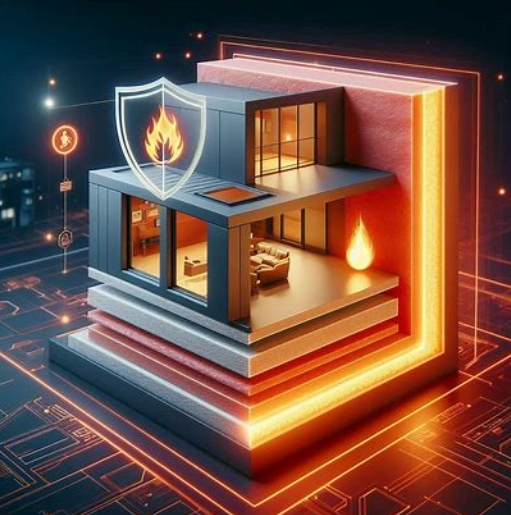Fire safety is an essential aspect of building design and construction. One of the most effective ways to ensure safety is by using fireproof insulation, a key component of passive fire protection. Unlike active fire systems that require manual or automatic activation (such as sprinklers), passive fire protection works behind the scenes to slow the spread of fire and minimize damage.
What is Fireproof Insulation?
Fireproof insulation is a specialized material designed to resist flames and high temperatures. It plays a critical role in preventing the rapid spread of fire and protecting structural integrity.
Key Benefits
- Reduces fire hazards
- Slows down heat and flame spread
- Enhances the durability of buildings
The Role of Passive Fire Protection
Passive fire protection (PFP) is essential in safeguarding lives and property by containing fire and preventing it from spreading. It works by using fire-resistant materials in walls, ceilings, floors, and structural elements to compartmentalize fire outbreaks.
Types of Fireproof Insulation
- Fire-Resistant Foams: These foams expand when exposed to heat, sealing gaps and preventing fire from spreading.
- Mineral Wool: This insulation is made from natural stone and is highly resistant to fire and heat.
- Fiberglass Insulation: A common material that provides fire resistance while also offering thermal insulation.
- Spray-On Fireproofing: Applied to steel structures, this coating enhances fire resistance and prevents structural collapse.
- Intumescent Coatings: These coatings expand when exposed to high temperatures, forming a protective barrier against flames.
How Fireproof Insulation Works
Fireproof insulation works by resisting heat, slowing down fire spread, and protecting structural elements from extreme temperatures. It acts as a barrier that delays combustion and minimizes the damage caused by flames and smoke.
Heat Absorption and Dissipation
Fireproof insulation materials are designed to absorb and disperse heat, preventing excessive temperature buildup. This slows down the rate at which fire spreads, allowing more time for evacuation and emergency response.
Limiting the Spread of Fire
By forming a protective layer, fireproof insulation prevents fire from rapidly traveling through walls, ceilings, and floors. This containment helps keep the fire localized, reducing overall destruction.
Preventing Structural Collapse
High temperatures weaken building materials like steel and concrete. Fireproof insulation protects these structural components by reducing heat exposure, preventing catastrophic failure during a fire.
Expanding and Sealing Gaps
Some fireproof insulation materials, such as intumescent coatings and fire-resistant foams, expand when exposed to heat. This expansion seals cracks and openings, stopping flames and toxic smoke from spreading through walls and ventilation systems.
Reducing Smoke and Toxic Gas Emission
Certain fireproof insulation materials help minimize the production of smoke and hazardous gases, improving air quality and visibility during a fire emergency.
Regulations and Standards for Fireproof Insulation
Buildings must comply with fire safety regulations set by local and international bodies. Fireproof insulation should meet NFPA, ASTM, and ISO standards to ensure effectiveness.
Applications of Fireproof Insulation
Fireproof insulation is widely used in residential, commercial, and industrial settings. It is particularly crucial in high-risk areas like factories, data centers, and hospitals.
Advantages of Fireproof Insulation
- Enhanced safety: Protects lives and reduces fire damage.
- Structural integrity: Prevents buildings from collapsing.
- Energy efficiency: Many fireproof insulation materials also improve energy conservation.
Challenges in Fireproof Insulation
- Cost: High-quality fireproof materials can be expensive.
- Installation Complexity: Some insulation types require professional installation.
Comparing Passive and Active Fire Protection
| Feature | Passive Fire Protection | Active Fire Protection |
| Function | Slows fire spread | Extinguishes fire |
| Requires Activation? | No | Yes (manual or automatic) |
| Examples | Fireproof insulation, fire-resistant walls | Sprinklers, fire extinguishers |
Common Myths About Fireproof Insulation
Myth 1: Fireproof Insulation Makes a Building Fireproof: While it slows fire spread, it does not make a structure completely fireproof.
Myth 2: All Insulation is Fireproof: Not all insulation is fire-resistant. Some materials, like polystyrene, can be highly flammable.
Conclusion
Fireproof insulation is a vital component of passive fire protection, ensuring safety in homes and businesses. Investing in the right fire-resistant materials can save lives and reduce damage in case of fire emergencies.
Recommended posts
The Ultimate Guide to michael d. cutler l3harris: Leadership, Impact, and Vision
2.0 kia soul korea export container enginshipping e
planta de fluidos de perforación en punata camacho: Innovation and Technology in the Oil Industry






